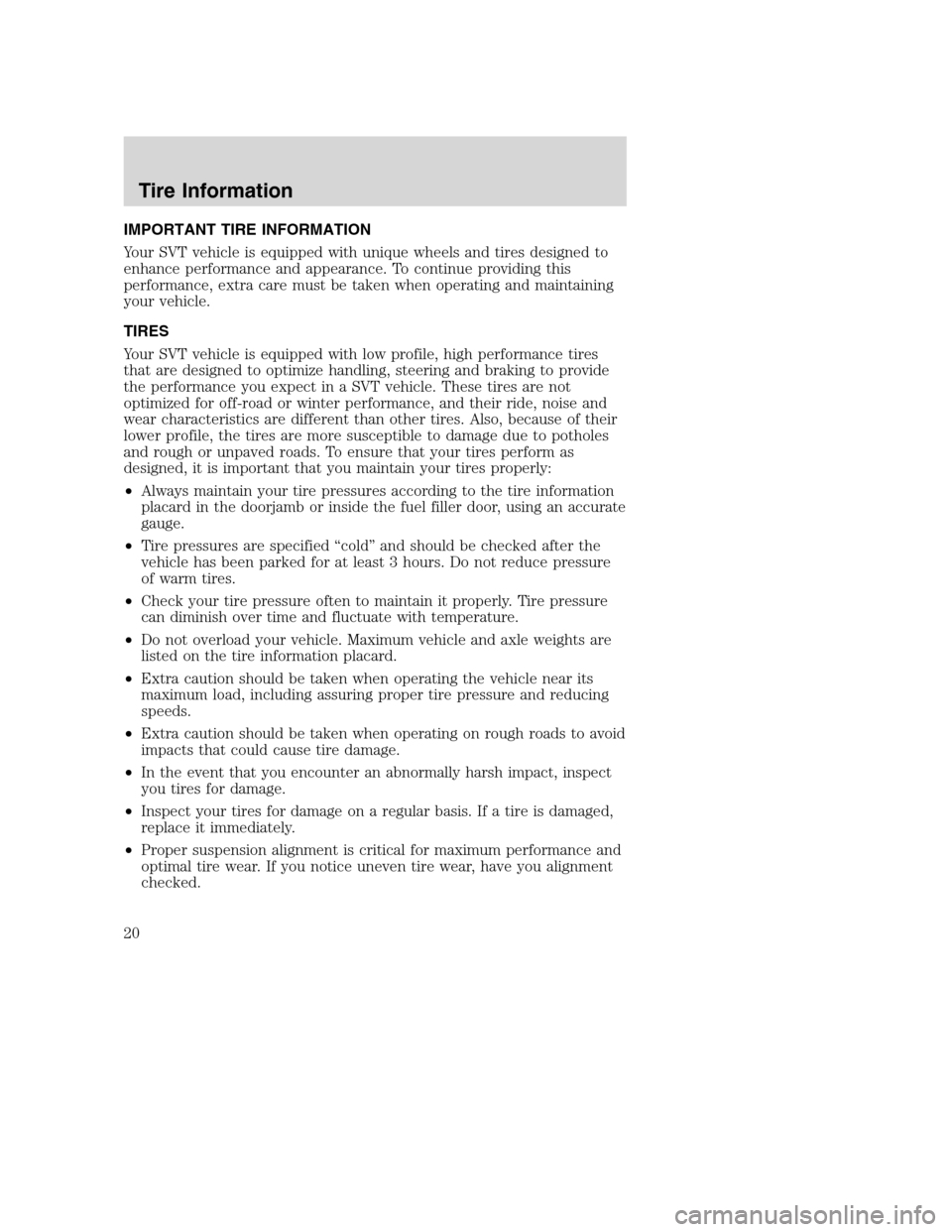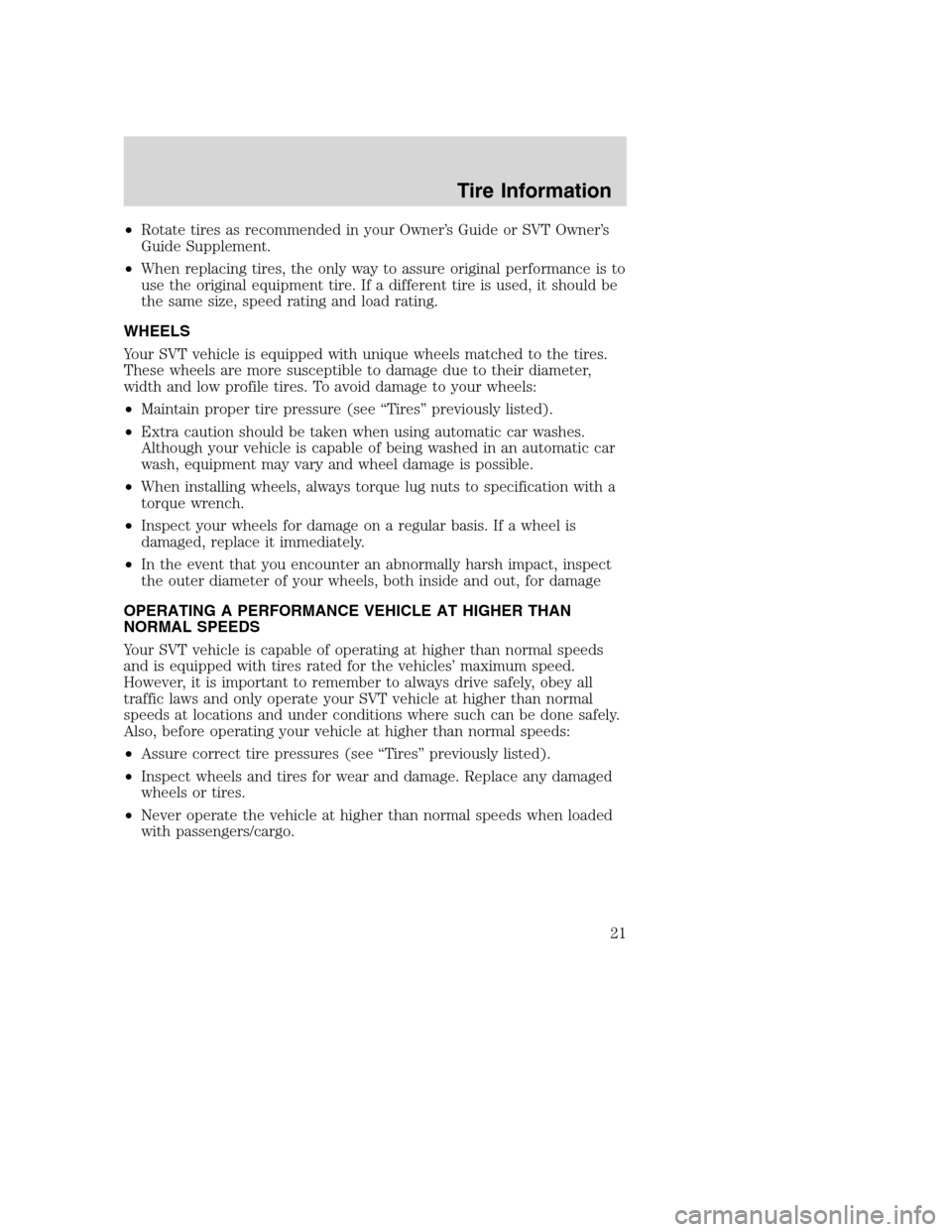Page 17 of 24
WHEELS AND TIRES
Tires295/45 ZR 18 BSW tires
WheelsSVT-Signature style, 18 in x 9.5 in
aluminum 5-spoke wheels
TIRE ROTATION
Because your vehicle’s tires perform
different jobs, they often wear
differently. To make sure your tires
wear evenly and last longer, rotate
them as indicated in the scheduled
maintenance guide. If you notice
that the tires wear unevenly, have
them checked.
SPARE TIRE AND WHEEL
Your vehicle is equipped a 235/70R-16 spare tire on a steel wheel rim.
This is for temporary use only. Replace this spare tire with a repaired
road tire as soon as possible.
Maintenance
17
Page 18 of 24

ATTACHING SAFETY SEATS WITH LATCH (LOWER ANCHORS
AND TETHERS FOR CHILDREN) ATTACHMENTS FOR CHILD SEAT
ANCHORS (IF EQUIPPED)
Some child safety seats have two rigid or webbing mounted attachments
that connect to two anchors at certain seating positions in your vehicle.
This type of child seat eliminates the need to use seat belts to attach the
child seat. For forward-facing child seats, the tether strap must also be
attached to the proper tether anchor. SeeAttaching safety seats with
tether strapsin this chapter.
Your vehicle may be equipped with LATCH anchors for child seat
installation at the following seating positions:
Connectors on the LATCH child seat
and the child seat instructions may
use the symbol shown here. Your
vehicle seat may have plain buttons,
instead of this symbol, to indicate the location of the LATCH lower
anchors.
The lower anchors for child seat
installation are located at the rear
section of the seat between the
cushion and seat back. The LATCH
anchors are below the locator
buttons (if provided) on the seat
back.
Place the passenger seat back in its upright position. Slide the passenger
seat rearward to its rearmost position. Place the passenger seat back it
its rearmost recline position.
Follow the child seat manufacturer’s instructions to properly install a
child seat with LATCH attachments.
Once child seat is attached, rotate the passenger seat back forward to its
most allowable upright locked position.
Child Seat Installation
Child Seat Installation
18
Page 19 of 24
Attach LATCH lower attachments of the child seat only to the
anchors shown.
If you install a child seat with rigid LATCH attachments, do not tighten
the tether strap enough to lift the child seat off the vehicle seat cushion
when the child is seated in it. Keep the tether strap just snug without
lifting the front of the child seat. Keeping the child seat just touching the
vehicle seat gives the best protection in a severe crash.
Each time you use the safety seat, check that the seat is properly
attached to the lower anchors and tether anchor. Try to tilt the child
seat from side to side. Also try to tug the seat forward. Check to see if
the anchors hold the seat in place.
If the safety seat is not anchored properly, the risk of a child
being injured in a crash greatly increases.
Child Seat Installation
19
Page 20 of 24

IMPORTANT TIRE INFORMATION
Your SVT vehicle is equipped with unique wheels and tires designed to
enhance performance and appearance. To continue providing this
performance, extra care must be taken when operating and maintaining
your vehicle.
TIRES
Your SVT vehicle is equipped with low profile, high performance tires
that are designed to optimize handling, steering and braking to provide
the performance you expect in a SVT vehicle. These tires are not
optimized for off-road or winter performance, and their ride, noise and
wear characteristics are different than other tires. Also, because of their
lower profile, the tires are more susceptible to damage due to potholes
and rough or unpaved roads. To ensure that your tires perform as
designed, it is important that you maintain your tires properly:
•Always maintain your tire pressures according to the tire information
placard in the doorjamb or inside the fuel filler door, using an accurate
gauge.
•Tire pressures are specified“cold”and should be checked after the
vehicle has been parked for at least 3 hours. Do not reduce pressure
of warm tires.
•Check your tire pressure often to maintain it properly. Tire pressure
can diminish over time and fluctuate with temperature.
•Do not overload your vehicle. Maximum vehicle and axle weights are
listed on the tire information placard.
•Extra caution should be taken when operating the vehicle near its
maximum load, including assuring proper tire pressure and reducing
speeds.
•Extra caution should be taken when operating on rough roads to avoid
impacts that could cause tire damage.
•In the event that you encounter an abnormally harsh impact, inspect
you tires for damage.
•Inspect your tires for damage on a regular basis. If a tire is damaged,
replace it immediately.
•Proper suspension alignment is critical for maximum performance and
optimal tire wear. If you notice uneven tire wear, have you alignment
checked.
Tire Information
Tire Information
20
Page 21 of 24

•Rotate tires as recommended in your Owner’s Guide or SVT Owner’s
Guide Supplement.
• When replacing tires, the only way to assure original performance is to
use the original equipment tire. If a different tire is used, it should be
the same size, speed rating and load rating.
WHEELS
Your SVT vehicle is equipped with unique wheels matched to the tires.
These wheels are more susceptible to damage due to their diameter,
width and low profile tires. To avoid damage to your wheels:
• Maintain proper tire pressure (see “Tires” previously listed).
• Extra caution should be taken when using automatic car washes.
Although your vehicle is capable of being washed in an automatic car
wash, equipment may vary and wheel damage is possible.
• When installing wheels, always torque lug nuts to specification with a
torque wrench.
• Inspect your wheels for damage on a regular basis. If a wheel is
damaged, replace it immediately.
• In the event that you encounter an abnormally harsh impact, inspect
the outer diameter of your wheels, both inside and out, for damage
OPERATING A PERFORMANCE VEHICLE AT HIGHER THAN
NORMAL SPEEDS
Your SVT vehicle is capable of operating at higher than normal speeds
and is equipped with tires rated for the vehicles’ maximum speed.
However, it is important to remember to always drive safely, obey all
traffic laws and only operate your SVT vehicle at higher than normal
speeds at locations and under conditions where such can be done safely.
Also, before operating your vehicle at higher than normal speeds:
• Assure correct tire pressures (see “Tires” previously listed).
• Inspect wheels and tires for wear and damage. Replace any damaged
wheels or tires.
• Never operate the vehicle at higher than normal speeds when loaded
with passengers/cargo.
Tire Information
21
Page 22 of 24
WINTER DRIVING
The original equipment tires on your SVT vehicle are designed for
maximum performance in dry and wet conditions. They are not designed
for winter use on ice or snow and cannot be used with snow chains. If
you will be operating your vehicle in these conditions, winter or
all-season tires must be used. Contact the Ford SVT Hotline at
1–800–FORD-SVT for information on SVT recommended winter tires for
your vehicle. When using winter or all-season tires:
•Always use winter tires on all 4 wheels and use 4 of the same size,
brand and model.
•Be aware that winter or all-season tires will not perform as well as the
original equipment tire in dry and wet conditions. Expect handling,
steering and braking to be degraded.
•Do not use a winter tire with less than a“T”rating, and even with
clear, dry driving conditions do not operate your vehicle above posted
speed limits while using winter tires. Never perform high-speed driving
with winter tires.
Tire Information
22
Page 23 of 24
A WORD ABOUT WARRANTY COVERAGE
The F–150 Lightning carries the same warranty coverage as other Ford
F-150 models. This information is covered in its entirety in the Ford
Motor Company Warranty Guide.
The F–150 Lightning or any SVT can be serviced under warranty at any
Ford-Lincoln-Mercury dealer nationwide.
SVT does not recommend modifying or racing our vehicles, as they are
designed and built to be driven as delivered from the factory. The Ford
Motor Company Warranty Guide discusses the installation of aftermarket
parts and their effect on warranty coverage as follows:
Repairs are not reimbursable under warranty when:
•“The repairs are required because of abuse, misuse, racing, fire,
negligence, accident, modification or a natural disaster.”
•“The repairs are required due to installation of a non-Ford part.”
A word about warranty coverage
A word about warranty coverage
23
Page 24 of 24
Page:
< prev 1-8 9-16 17-24